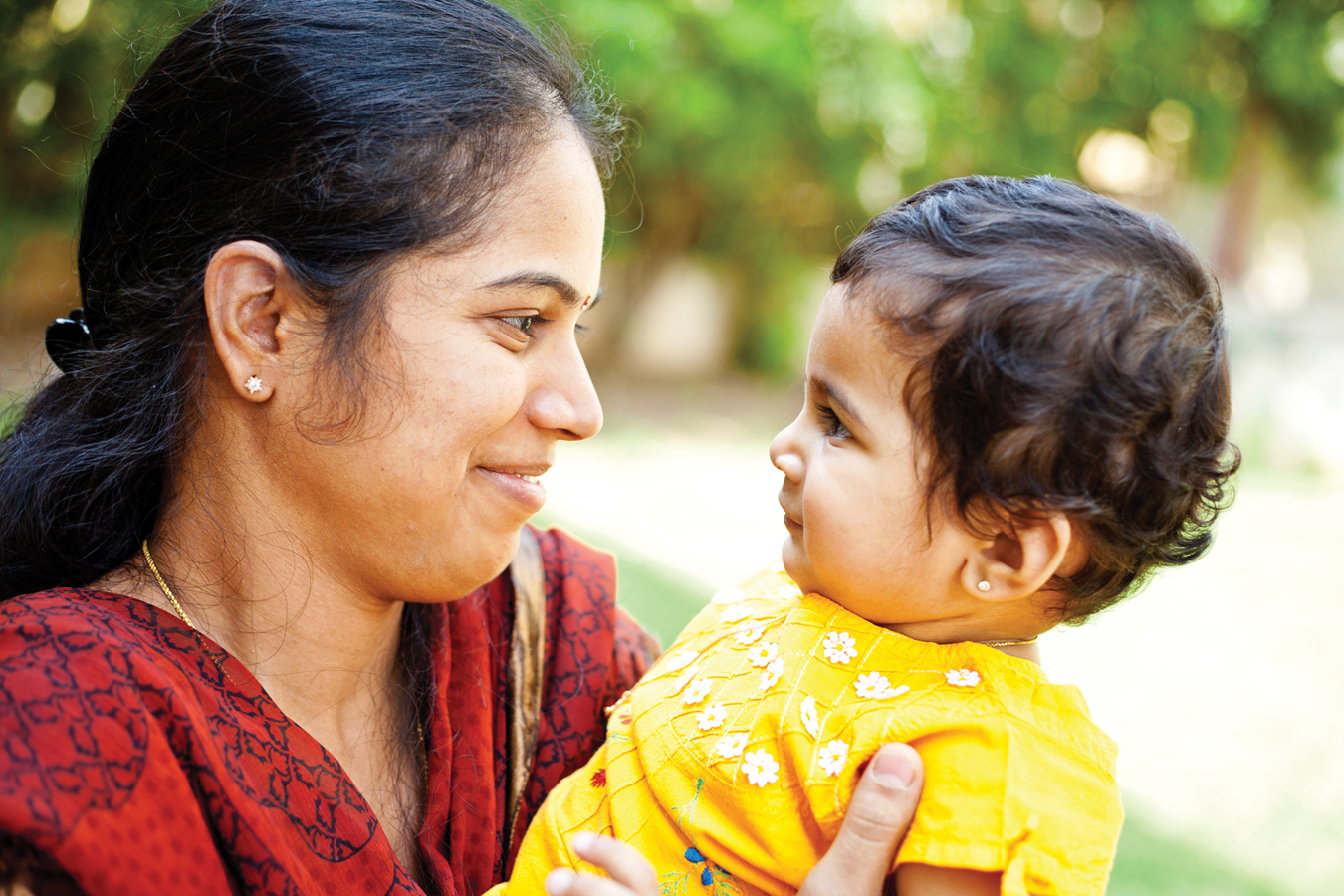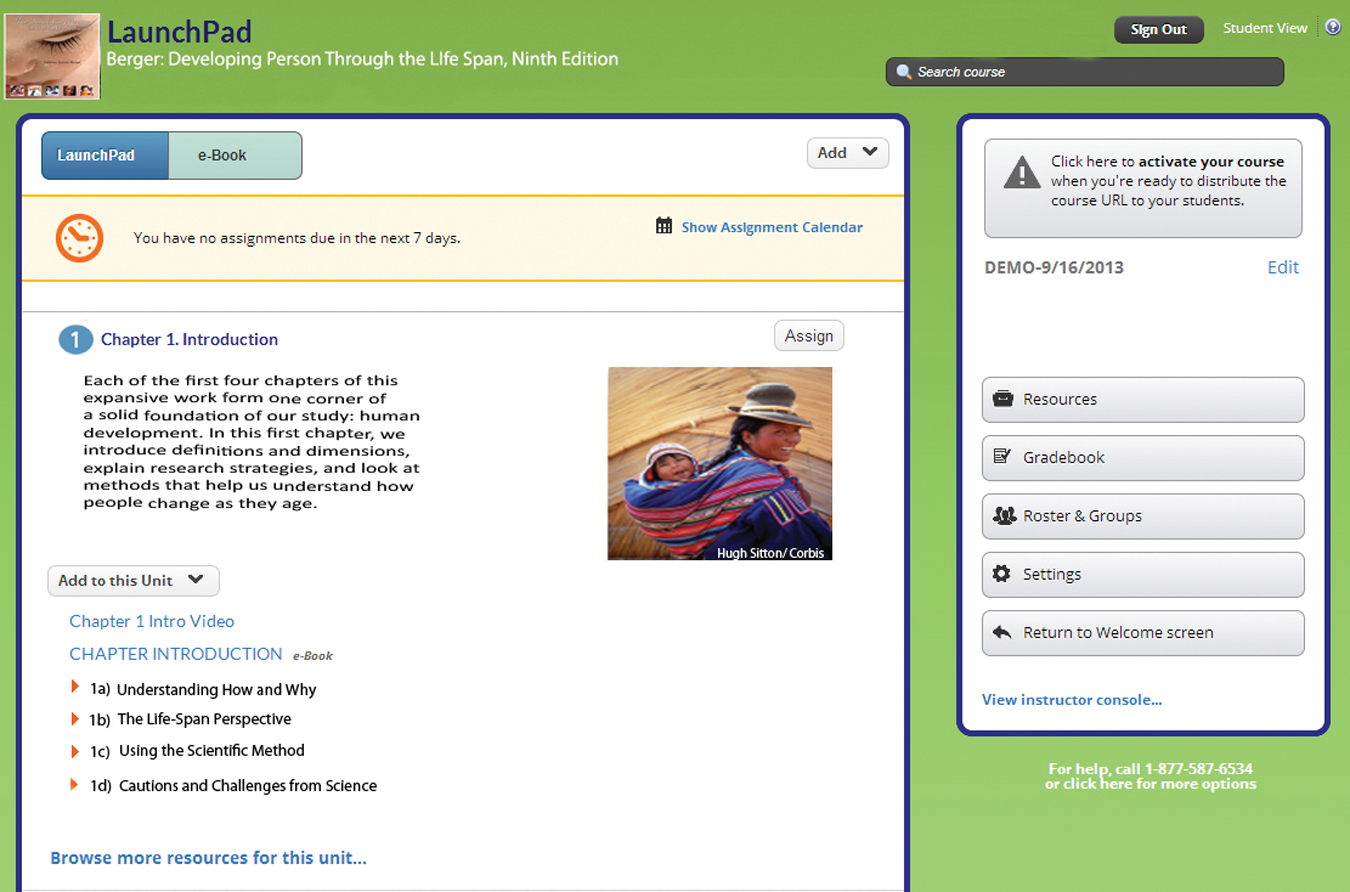Preface
My grandson, Asa, is in early childhood. He sees the world in opposites: male/female, child/grown-

Oscar, his father, knows better. He asked me if Asa really believes there are good guys and bad guys, or is that just a cliché. I said that most young children believe quite simple opposites.
Undeterred, Oscar told Asa that he knows some adults who were once bad guys but became good guys.
“No,” Asa insisted. “That never happens.”
Asa is mistaken. As he matures, his body will grow taller but become less active, and his mind will appreciate the development of human behavior as life goes on. This book describes how our thoughts and actions change over the lifespan, including that almost nothing “never happens” as humans grow older.
Oscar is not alone in realizing that people change. Many common sayings affirm development over time: People “turn over a new leaf,” are “born-
The complexity, the twists and turns, the endless variety of the human experience at every age is fascinating to me, which is why I wrote this book. We all have echoes of Asa in us: We want life to be simple, for people to be good guys. But life is not simple. Learning about human growth helps everyone respond to life’s variations and influences, not with imaginary kicks but with wise responses. Knowledge does that. In a vivid example, Stephen Pinker (2011) finds that humans kill each other less now than they did in previous centuries; he cites education as one reason.
Education occurs in hundreds of ways. This textbook is only one of them, an aid to understanding the complexity of your life, my life, and the lives of all the estimated 18 billion humans alive now or who once lived. Nonetheless, although life experiences and thousands of other books contribute to our education, writing this text is my contribution and studying it is yours: Together we might learn how to limit the bad and increase the good in each of us as time goes on.
New Material

Every year, scientists discover and explain more concepts and research. The best of these are integrated into the text, including hundreds of new references on many topics—
xviii
Genetics and social contexts are noted throughout. The variations and hazards of infant day care and preschool education are described; emerging adulthood is further explained in a trio of chapters; the blurry boundaries of adulthood are stressed; the various manifestations, treatments, and prevention of neurocognitive disorders (not just Alzheimer disease) are discussed; and much more.
New Pedagogical Aids

This edition incorporates learning objectives at the beginning of each chapter: The “What Will You Know?” questions indicate important concepts for students to focus on. There is also a new element at the end of each chapter: The “What Have You Learned?” questions help students assess their learning in more detail. Some further explanation follows.
Learning Objectives
Much of what students learn from this course is a matter of attitude, approach, and perspective—
Ideally, students answer the learning objective questions in sentences, with specifics that demonstrate knowledge. Some items on the new lists are straightforward, requiring only close attention to the chapter content. Others require comparisons, implications, or evaluations.
xix
New Opposing Perspectives Boxed Feature and Updated A View from Science and A Case to Study Features
We all need to develop our critical thinking skills. Virtually every page of this book presents not only facts but also questions with divergent interpretations. A new boxed feature called Opposing Perspectives appears in this edition of The Developing Person Through the Life Span for the first time. This box focuses on exciting and controversial topics in development—
In addition, the boxes titled A View from Science, which explain surprising insights from recent scientific research, and A Case to Study, which illustrate developmental issues through the story of specific individuals, have been extensively updated. All these new features are included in the table of contents.
Visualizing Development
Also new to this edition are full-
New Child Development and Nursing Career Appendices
Available online, these new resources link the content of the life-
Content Changes to the Ninth Edition
Life-
Part I: The Beginnings
- 1. The Science of Human Development
- A new chapter opener focuses on Kathleen Berger’s (embarrassing) experience at the birth of her grandson, Caleb.
- Comprehensive explanation of the difference-
equals- deficit error is used to highlight the importance of a multicultural approach in developmental science. - An Opposing Perspectives feature box introduces students to the controversies surrounding the use of the word “race” in the social sciences.
- An explanation of genetics and epigenetics now appears in this introductory chapter as an example of why the study of human development needs to take a multidisciplinary approach.
- A new section on researching the topic of depression provides students with a concrete illustration of the way a multidisciplinary approach can lead to a better understanding of a particular issue.
- Dynamic systems theory and the concept of differential sensitivity are used to explain the plasticity of human development.
 Before Words The New York infant interpreting a smile is doing what babies do: trying to understand communications long before they are able to talk.SOURCE: VIKRAM RAGHUVANSHI/GETTY IMAGES
Before Words The New York infant interpreting a smile is doing what babies do: trying to understand communications long before they are able to talk.SOURCE: VIKRAM RAGHUVANSHI/GETTY IMAGESxx
- 2. Theories of Development
- The controversial text of Battle Hymn of the Tiger Mother is used as an example to illustrate the popularity and ubiquity of theories of human development.
- A new section on Comparing Grand Theories provides thought-
provoking comparisons between psychoanalytic, behavioral, and cognitive theories. - A new feature box on Toilet Training illustrates exactly how various theoretical schools can take radically different approaches to a particular issue.
- An expanded account of sociocultural theory explains the pervasiveness of cultural influences on individual people and the extent to which scientists now acknowledge these influences in their studies.
- A View from Science feature box explores the way evolutionary theory accounts for sexual jealousy between men and women.
 Bliss for Boys But not for moms. Finger painting develops fine motor skills, which is why it is part of the curriculum in early childhood. This boy shows why most stay-
Bliss for Boys But not for moms. Finger painting develops fine motor skills, which is why it is part of the curriculum in early childhood. This boy shows why most stay-at- home 3- year- olds miss out on this joy. SOURCE: AMY WHITT/RADIUS IMAGES/GETTY IMAGES - 3. Heredity and Environment
- New material on copy number variations as a type of interaction between genes that correlates with a large number of diseases and conditions.
- An expanded discussion of genetic counseling that includes criteria for determining when a pregnant woman should be informed about genetic disorders that tests have detected in her fetus.
- 4. Prenatal Development and Birth
- Updated data on rates of cesarean deliveries in the United States and around the world.
- A new discussion of innate vulnerability as a factor that influences the effects of teratogens on prenatal development.
- New material on the responsibility of doctors and scientists in advising pregnant women about avoiding various teratogens.
- Expanded discussion of problems associated with low birthweight, including the complementary roles of mothers and fathers.
- A new section on the way the parental alliance can have a healthy influence on pregnancy and birth.
Part II: The First Two Years
- 5. The First Two Years: Biosocial Development
- A new View from Science feature box on Face Recognition outlines the role of experience in the development of dendrites in the fusiform face area of the brain, which in turn gives babies the ability to recognize faces.
- New material on Harming the Infant Brain explores several sources of harm and successful interventions.
- An expanded section on Touch and Pain summarizes current scientific thought on infants’ experience of pain.
- A new section on Dynamic Sensory-
Motor Systems connects dynamic systems theory with a baby’s growing ability to coordinate senses and skills. - Updated data on infant death rates around the world show the way improved public health measures have increased infant survival rates.
- An account of Susan Beal’s research into sudden infant death syndrome now ends this chapter, summarizing the complexity of infant care and the way many factors interact to produce any one result.
xxi
- 6. The First Two Years: Cognitive Development
- A new section on Piaget and Modern Research focuses on the limitations of Piaget’s conclusions about Sensorimotor Intelligence that have come to light in more recent studies.
- The section called Research on Early Affordances has been updated to include new research on the influence of social context on early affordances.
- A new feature box on Language and Video discusses the connection between a toddler’s interpersonal relationships and his or her intellectual growth, cautioning against the claims of certain commercial “educational” products.
- In the section on Information Processing there is more of an emphasis on the active nature of the young child’s brain and the influences of experiences and memory on what the child knows.
- 7. The First Two Years: Psychosocial Development
- A new discussion of Social Awareness complements that on Self-
Awareness in the section on the emotional development of toddlers. - The section on brain growth and its links to this stage of child development is expanded.
- A discussion of Romanian orphans is used to illustrate the hazards associated with insecure attachment.
- A new section on Preventing Problems discusses ways of avoiding insecure attachment between new parents and their babies.
- The discussion of proximal and distal parenting has been expanded and highlighted by placing it in an Opposing Perspectives feature box.
- In the section on theories, there are new discussions of Humanism and Evolutionary Theory and the way they apply to this stage of development.
- A new discussion of Social Awareness complements that on Self-
Part III: Early Childhood
- 8. Early Childhood: Biosocial Development
- Treatment of stress hormones and their effects on the limbic system is expanded.
- The discussion of Nutritional Deficiencies has been expanded to include recent research on food allergies.
- The section on prevention of avoidable injuries has been reorganized to place a greater emphasis on cultural variations.
- A new feature box describes the way scientific research encouraged the elimination of lead from paints and gasoline in the United States and the positive effects this has had on child development.
- 9. Early Childhood: Cognitive Development
- The discussion of Piaget’s Preoperational Thought has been expanded to include the use of symbolic thought by young children.
- Vygotsky’s Social Learning Theory is applied to the recent emphasis on STEM (Science, Technology, Engineering, Math) education and possible implications for early childhood learning.
- Under Language Learning there is new material on the activities in early childhood that aid later literacy in elementary school.
- A new section covers recent research into strategies for enhancing bilingual education in early childhood.
xxii
- 10. Early Childhood: Psychosocial Development
- The opening section on Emotional Development has been reorganized and rewritten to emphasize the connection with brain maturation during early childhood.
- In the section on Motivation, there is a new discussion of why young children create imaginary friends.
- Under Play, the discussion of the importance of culture and cohort has been significantly expanded.
- The expanded treatment of Challenges for Caregivers discusses not only parents but also other significant adults in a child’s life.
- The discussion of theoretical approaches to sex and gender has been broadened to include sociocultural theory, humanism, and evolutionary theory.
- The nature/nurture controversy as it applies to early childhood behavior is treated in greater detail.
- Under the topic of discipline, there is a new Opposing Perspectives box on the pros and cons of spanking.
Part IV: Middle Childhood
- Chapter 11: Middle Childhood: Biosocial Development
- Extensively updated coverage of psychopathology in childhood including updated coverage of Autism Spectrum Disorder, ADHD, and Specific Learning Disorders.
- New A Case to Study on Lynda, about a young girl with psychological difficulties, whose case is “diagnosed” by a number of professionals, leading to a critical thinking discussion of the challenges in treating and understanding childhood psychopathology.
- New section on gifted education.
- New A View from Science box on childhood obesity.
- Chapter 12: Middle Childhood: Cognitive Development
- Updated and extensive section on the international contexts for the growth in childhood cognition, including an extended example of the sense of direction among children in Varanasi, a city in India.
- Updated discussion of international tests and international schooling, including material on the Finnish educational success story.
- New discussion of the Common Core standards.
- Chapter 13: Middle Childhood: Psychosocial Development
- New chapter-
opening vignette about an 8- year- old boy whose father says he’s too young to play video games in which he kills zombies. - Updated discussion and understanding of risk and resilience, focusing on epigenetics—
and the fact that differential sensitivity may mean that what is beneficial to one child may be stressful for another. - New A Case to Study about child neglect and how to recognize it in children in school.
- New chapter-
Part V: Adolescence
- Chapter 14: Adolescence: Biosocial Development
- New research on sleep deprivation, including the observation that the light from computers, video games, and even cell phones can interrupt circadian rhythms and interfere with teenagers’ natural nighttime sleepiness.
- New coverage of new DSM-
5 diagnosis of binge eating disorders. - Updated data about the timing of adolescent sexual activity.
xxiii
- Chapter 15: Adolescence: Cognitive Development
- New section on the impact of technology on adolescents Digital Natives, which includes material on potential Internet and video game addiction, sexting, and cyberbullying.
- New chapter-
opening vignette about the challenges of teaching sometimes “egocentric” adolescents in high school. - Updated research, including the work of Daniel Kahneman (the Nobel Prize—
winning psychologist) on logical fallacies. - New research on what motivates students to succeed in middle and high school, including theories about students’ beliefs about what causes school success.
- New material on high-
stakes testing in high school, including coverage of the Common Core and updated international tests including the PISA.
- Chapter 16: Adolescence: Psychosocial Development
- New material on culture and cultural differences and similarities in parent-
child relationships across the world. - Updated section and data on relationships between same-
sex adolescents. - New coverage of the impact of culture and context, particularly among Latino/Latina youths and gay youths, on depression in adolescence.
- New Opposing Perspectives box on teenage rage, asking students to think critically about whether rage and rebellion are a culturally determined or universal part of the adolescent experience.
- New material on culture and cultural differences and similarities in parent-
Part VI: Emerging Adulthood
- Chapter 17: Emerging Adulthood: Biosocial Development
- Material on homeostasis, organ reserve, and allostatis has been moved to this chapter.
- Significantly reorganized and updated material on psychopathology in emerging adulthood, reflecting new DSM-
5 categorizations. - New Opposing Perspectives box on risk-
taking in early adulthood. - Updated material on abuse of drugs, including coverage of energy drinks and ketamine, and social-
norms theories of drug- abuse prevention.
- Chapter 18: Emerging Adulthood: Cognitive Development
- Updated research on stereotype threat and its power to influence the success of college students.
- Updated data on trends in higher education, including the increasing costs of college and use of technology in the classroom (including the “flipped classroom” and MOOCs).
- Chapter 19: Emerging Adulthood: Psychosocial Development
- Updated material on vocation and vocational identity in emerging adulthood, with coverage of John Holland’s research and the recent economic challenges faced by young adults.
- New coverage of the importance of plasticity in emerging adulthood, including the concept of “plasticity genes,” which reiterates the ongoing coverage in this book of epigenesis—
the impact of environment on gene expression throughout the life span. - Updated material on how use of the Internet and social media enhances friendships during emerging adulthood.
- New coverage of “churning” relationships which start and stop frequently and are characterized by conflict.
- Updated coverage of the relationship between emerging adults and their parents (which tends to be closer than ever before).
xxiv
Part VII: Adulthood
- Chapter 20: Adulthood: Biosocial Development
- Updated research on aging vision and senses.
- New material on the use of hormone replacement therapy for aging men and women, and adult obesity.
- Chapter 21: Adulthood: Cognitive Development
- Updated data on IQ changes in adulthood, including cohort and generational effects.
- Chapter 22: Adulthood: Psychosocial Development
- New chapter-
opening vignette on Kathleen Berger’s broken bones, illustrating the web of connection in adulthood. - New material on culture and variations in adult children’s relationships with their parents.
- Updated section on sibling and “fictive kin” relationships.
- Updated section on possible predictors of marital happiness and new research on same-
sex marriage and adoption. - New box focusing on diversity in the workplace and the harm caused by “microaggression” among co-
workers.
- New chapter-
Part VIII: Late Adulthood
- Chapter 23: Late Adulthood: Biosocial Development
- New box on sex in later adulthood—
focusing on how satisfied many older adults are with their sexuality. - New material on driving in late adulthood, including material on policy issues and changes in our senses as we age.
- Recent research on normative brain changes in late adulthood, including coverage of brain shrinkage.
- Updated research on the theories of aging and controversies over how to delay it—
including calorie restriction, sirtuins, and reversatrol.
- New box on sex in later adulthood—
- Chapter 24: Late Adulthood: Cognitive Development
- Significantly revised and updated presentation on neurocognitive disorder to reflect the new DSM-
5 categorization. - Significantly updated and revised discussion of brain function and cognitive processes during aging, including developments in memory and executive control processes.
- New boxes on cognitive errors during adulthood, focusing on dual processing and intelligence testing in late adulthood.
- Significantly revised and updated presentation on neurocognitive disorder to reflect the new DSM-
- Chapter 25: Late Adulthood: Psychosocial Development
- New coverage of compulsive hoarding, a new DSM-
5 diagnosis. - New Opposing Perspectives box on positive world view among elders.
- Updated section on employment in late adulthood to reflect the fact that many elders are still in the workforce, or would like to be.
- New coverage of compulsive hoarding, a new DSM-
- Epilogue
- Updated coverage of hospice care in the U.S. and around the world.
- New material on planning for the end of life, including coverage of advanced directives.
- Updated material on bereavement and grief.
Ongoing Features
Many characteristics of this book have been acclaimed since the first edition and have been retained in this revision.
xxv
Writing That Communicates the Excitement and Challenge of the Field
An overview of the science of human development should be lively, just as real people are. Each sentence conveys tone as well as content. Chapter-
Coverage of Brain Research

Inclusion of the exciting results from neuroscience is now a familiar feature of this book. Brain development is the most obvious example: Every trio of chapters includes a section on the brain, often enhanced with charts and photos to help students understand its inner workings. The following list highlights some of this material.
The role of dopamine, serotonin, and growth factors such as GDNF in depression, p. 17
Epigenetics and brain function in depressed individuals, pp. 17–
PET scans of brains of a depressed and a non-
Neuroscience and the limits of Piaget’s developmental theory, p. 47
Brain scans of adults with ADHD, p. 48; illustrated, p. 48
Influence of copy number variations on basic brain structures, p. 80
Prenatal growth of the brain, pp. 98–
Teratogenic effects on brain development, p. 106–
Brain development in the first two years, pp. 129–
Experience-
Brain immaturity and cross-
Implication of low serotonin levels in SIDS, p. 150
Limitations of Piaget’s theory as revealed by brain scans, pp. 161–
Techniques of infant brain scans, p. x; illustrated, p. 162
Mirror neurons and infant cognition, p. 162
Brain developments that support social emotions, pp. 185–
The effect of the stress hormone cortisol on the developing brain, p. 186
Genetic influences on temperament, especially the combination of DRD4 VNTR and 5-
Brain maturation and synchrony, p. 191
Attachment and brain development, p. 195
A View from Science: the effect of lead exposure on brain development, pp. 230–
Brain development in early childhood (prefrontal cortex, myelination, lateralization, the limbic system), pp. 219–
Abnormal growth of the corpus callosum and ADHD, p. 223
Maturation of the prefrontal cortex and theory of mind, p. 254; illustrated p. 255
Cultural differences in executive function among 5-
The influence of myelination of the limbic system and growth of the prefrontal cortex in development of emotional regulation, pp. 276–
The effects of physical exercise on the brain, p. 311
Brain development in middle childhood, pp. 318–
Neurological advances and selective attention, p. 319
Neurological scans confirm usefulness of information-
xxvi
Development of control processes in middle childhood, p. 346
Brain abnormality as a possible factor in bullying, p. 387
The role of the pituitary gland in hormone production, pp. 402–
The role of the brain in regulating circadian rhythms, pp. 403–
Adolescent brain development; heightened arousal of reward areas of the brain, pp. 416–
Proportion of gray matter from childhood through adolescence, illustrated p. 416
Benefits of adolescent brain development, pp. 418–
Dual processing as a result of brain maturation, pp. 438–
Risk-
Neurological factors as predictors of delinquency in adolescence, p. 477
Drug use and potential harm to the brain, pp. 478–
The impact of alcohol on the adolescent brain, p. 481
Physiological responses affecting neurological patterns, p. 502
Brain development and hormones as factors in risk-
Brain development and postformal thought, pp. 519–
Brain changes from age 14 to age 25, illustrated p. 520
Lust and affection centered in different brain areas, p. 553
The aging brain: neurological changes in adulthood, p. 577
Causes of severe brain loss before age 65, p. 577
Thirty distinct brain areas involved in vision, p. 579
Complications in calculating adult IQ due to brain changes, p. 605
Fluid intelligence and overall brain health, p. 609
The effects of stress on the brain, p. 615
Multitasking and the aging brain, p. 621
Brain changes due to experience and expertise, p. 626
Correlation between brain function and personality, p. 636, illustrated p. 637
Encoding of the sense of unfairness in the brain, p. 654
Compensation strategies for brain loss in late adulthood, pp. 676–
The aging brain: neurological changes in late adulthood, pp. 682–
Neurogenesis in late adulthood, p. 683
Brain abnormalities in neurocognitve disorders, p. 711
Specific genes associated with Alzheimer disease; scans of progress of AD, p. 712
Correlation between vascular dementia and the ApoE4 allele, p. 712
Repeated brain trauma as a precursor of dementia, p. 714
Expression of creativity and its impact on brain health, p. 722
Opposing Perspectives: brain activity in response to disappointment: differences between old, healthy individuals; old, depressed individuals; and young individuals, p. 733; illustrated p. 733
Brain death as determining factor in declaring a person legally dead, pp. 772–

Coverage of Diversity
Cross-
New research on family structures, immigrants, bilingualism, single adults, and ethnic differences in health are among the many topics that illustrate human diversity. Listed here is a smattering of the discussions of culture and diversity in this new edition. Respect for human differences is evident throughout. You will note that examples and research findings from many parts of the world are included, not as add-
xxvii
Inclusion of all kinds of people in the study of development, p. 4
Multicontextual considerations in development (SES, cohort, family configuration, etc.), pp. 7–
Culture defined; the need to include people of many cultures in developmental study, p. 11
Learning within a culture/cultural transmission (Vygotsky), p. 14
Race and ethnic group defined and discussed (includes Opposing Perspectives), pp. 14–
Genetic, biochemical, and neurological differences in adults with depression versus adults without depression; international differences in incidence of depression, pp. 17–
Age diversity in cross-
Age, gender, and immigrant/nonimmigrant differences in explanation of correlation, p. 29
Ethnotheories arising from a specific culture or ethnic group, p. 35
Developmental theories reflect historical and cultural influences of their time, p. 48
Vygotsky’s sociocultural theory, pp. 52–
Genetic variations among people: alleles, p. 69
Male and female sex chromosomes, pp. 70–
Opposing Perspectives: international differences in sex selection, pp. 71–
Rates of cesarean births in selected countries, p. 102
Birthing practices in various cultures, pp. 103–
Ethnic differences in the allele that causes low folic acid, p. 108
Rates of low birthweight in various countries, p. 115
Opposing Perspectives: cultural differences in co-
Infant mortality rates in various countries, p. 143
Breast-
International rates of stunting, p. 148
Malnutrition: wasting in developing nations, pp. 148–
Cultural and family differences in infants’ exposure to language and language use, pp. 171–
Understanding of emotional content of English by non-
Separation anxiety and stranger wariness in Japan and Germany, p. 183
Cultural differences in emotions encouraged in toddlers, p. 184
Cultural differences in activation of the anterior cingulate gyrus, p. 185
Genetic and gender differences in infant/toddler temperament, p. 188
Ugandan mothers’ contact-
Influence of SES on attachment type, p. 195
Outcomes for Romanian orphans adopted by North American, European, and
Australian families, p. 196
Danish father involvement with infants, p. 198
Gender differences in child care, pp. 198–
Opposing Perspectives: proximal and distal parenting in Cameroon, Greece, and Costa Rica, pp. 201–
International comparisons of infant caregiving differences, pp. 206–
Parental leave policies in selected countries, p. 207
A View from Science: correlation of blood lead levels and crime in various countries, pp. 230–

xxviii
Differences in the corpus callosum between right-
Culture as a determinant of how one thinks and acts (social learning, Vygotsky), pp. 249–
Study of overimitation in South Africa, Botswana, and Australia, p. 250
Cultural differences in development of theory of mind, pp. 255–
Bilingualism in various nations; ethnicity and bilingualism in the U.S.; English proficiency among U.S. children whose home language is not English, pp. 260–
Ethnic breakdown on children in preschool programs, p. 268
Effects of intervention programs on low-
Various cultures’ goals for emotional regulation in young children, p. 278
A View from Science: sex differences in emotional regulation, p. 280
Cultural differences in young children’s play, pp. 282–
Ethnic and SES differences in children’s activities, illustrated, p. 282
Cultural differences in caregiving styles, pp. 289–
Cultural differences in child discipline, pp. 299–
Opposing Perspectives: cultural attitudes towards spanking, pp. 301–
Attitudes towards children’s leisure time: U.S., Australia, South Korea, p. 312
Common leisure activities in various nations, p. 312
A View from Science: childhood obesity in the U.S., by ethnicity; genetic propensity toward obesity and diabetes, pp. 315–
Childhood asthma and ethnicity in the U.S., p. 317
Cultural considerations in IQ testing, p. 322
Consideration of children with special needs, pp. 323–
A Case to Study: difficulties in diagnosis of special needs, p. 327
Cultural differences (Vygotsky) and SES differences in school-
Curriculum differences in various countries, pp. 353–
Math and reading achievement in various countries, pp. 356–
Children’s second-
Class size and student performance in various countries, p. 362
Cultural differences in self-
Children’s reactions to stress in Louisiana (Hurricane Katrina), Sri Lanka (tsunami), and Sierra Leone (war and child soldiers), pp. 371–
SES and resilience, p. 372
Family function within various structures, including families headed by same-
International rates of single-
Percentage of one-
Effects of SES on family structure and function, pp. 382–
Shyness and popularity in North America and China, p. 386
Gender differences in bullying, p. 386
Efforts to control bullying in various nations, p. 388
Age-
Gender differences in children’s retribution/restitution behavior, pp. 393–
Ethnic differences in timing of puberty (U.S.), p. 406; in other nations, pp. 410–
Ethnic differences in median age of menarche, p. 406
Influence of body fat on onset of puberty (girls): ethnic differences and international examples, pp. 406–
Gender differences in reaction to early or late puberty, pp. 409–
Nutritional deficiencies: U.S. ethnic and international examples, pp. 413–
Ethnic differences in teen birth rates (U.S.); differences in other nations, p. 422
xxix
Condom use among teens in various nations, p. 425
Age differences in logical thinking, pp. 430–
Comparison of international scores on PISA, p. 453
Parent–
Formation of ethnic identity, pp. 467–
Adolescent same-
Differences in sex education, U.S. and Europe, pp. 472–
Gender, ethnic, and age differences in self-
Genetic and gender differences in risk of depression, p. 474
Gender differences in rates of teen parasuicide and suicide, pp. 474–
Opposing Perspectives: Is adolescent rebellion a social construction?—international comparisons, p. 476
International comparisons: adolescent use of alcohol and cigarettes, p. 479
Differences in teen drug use by age, gender and generation, pp. 479–
The effect of globalization on the spread of infectious diseases, including STIs, pp. 501–
Sex differences in experience of depression, p. 505
Gender differences in prevalence of risk-
Homicide victims and perpetrators, by age, p. 508
Differences in substance abuse, by age, p. 510
Stereotype threat—
Gender differences in morality, p. 530
Rates of college graduation in various nations, pp. 535–
Proliferation of universities in Asia and the Middle East, p. 536
Ethnic and gender diversity in college, and their effects, pp. 536–
Ethnic identity in emerging adulthood, pp. 544–
Gender and friendship, p. 552
National differences in acceptance and timing of cohabitation, pp. 556–
Ethnicity as a factor in romantic relationships, p. 561
National differences in relationship of emerging adults to their parents, pp. 565–
National and regional differences in fertility, p. 582
Cultural differences in acceptance of HRT, p. 585
Gender differences in incidence of lung cancer (U.S.), p. 587
Rates of smoking in men and women (U.S.), p. 588
International rates of overweight and obesity, p. 590
Ethnic and cultural influences on incidence of obesity, p. 591
Gender differences in rates of daily exercise, p. 592
Mortality rates by age, gender, and ethnicity, p. 594
Gender differences in life expectancy, various nations, p. 595
SES and health, pp. 589–
Gender and age differences in intellectual abilities, p. 606
Sex differences in response to stress, pp. 616–
Age and job effectiveness, p. 626
The influence of culture, age, and social context on personality in adulthood, pp. 634–
Opposing Perspectives: genetic and contextual influences on adult personality, pp. 636–
Income as a determinant of family structure for young, married couples in Thailand, p. 639
National differences in the quality of older adults’ relationships with their children, p. 639
Income and education as factors in marital happiness, p. 642
Ethnic differences in likelihood of divorce, p. 643

xxx

Gay and lesbian partners, p. 644
SES and ethnicity as factors in remarriage, p. 645
Ethnic differences in interdependence of family members, p. 652
Cultural determinants of family caregiving for the elderly, pp. 652–
Evolving gender differences in the U.S workforce; ethnic make-
A View from Science: accommodating diversity in the workplace, p. 656
Work schedules in the U.S. and Europe, p. 658
Cultural and age differences in ageist stereotypes; differences between hearing and nonhearing Americans, pp. 669–
Percent of population age 65 or older, selected nations, p. 673
Dependency ratio in developed and developing nations, p. 674
A Case to Study: gender differences in sexual desire and activity in late adulthood, pp. 677–
Death rates by cause of death in late adulthood relative to adulthood, p. 685
Age differences in drug testing and in the efficacy of medical interventions in the old and the young, p. 685
Gender difference in incidence of chronic and acute diseases, p. 686
Breakdown of U.S. population over 55, by age and gender, p. 686
Genetic diversity: alleles that promote or compromise longevity, pp. 689–
Correlation between high SES and high intellect in old age, p. 702
Age-
Disparity in prevalence of neurocognitive disorders in developed and developing nations; rates in selected nations, p. 711
Gender differences in prevalence of neurocognitive disorders, p. 711
Genetic propensity to developing Alzheimer disease, p. 712
Genetic propensity to developing vascular disorder, p. 712
The impact of gender, ethnic, and SES stratification, pp. 734–
Effects of ethnic stratification on Africa Americans and on U.S. immigrant elders, p. 735
Ethnic and age disparities in SES, p. 735
Average life expectancy compared by ethnicity and age (California), p. 735
Effects of age stratification, p. 736
SES as a factor in disengagement, p. 736
Culture and policy effects on volunteerism among the elderly, p. 739
Differences in national policies regarding care for the elderly, p. 745
Cultural differences in expectations about care of the elderly, U.S. and Asian cultures, p. 745
Cultural differences in the well-
Life expectancy compared: white and black men and women with and without a high school diploma, p. 747
Cultural and national differences in care for the frail elderly, pp. 751–
Death beliefs and practices in ancient Egypt and Greece, p. 762
Modern death beliefs and practices in different cultures/religions, p. 763
Age differences in response to death, pp. 763–
Ethnic and national differences in the availability and use of hospice care, pp. 770–
State, national, and cultural differences in attitudes toward and policies about euthanasia and physician-
Mourning rituals in various religions, pp. 780–
xxxi
Up-to-Date Coverage
My mentors welcomed curiosity, creativity, and skepticism; as a result, I am eager to read and analyze thousands of articles and books on everything from Alzheimer disease to zygosity. The recent explosion of research in neuroscience and genetics has challenged me, once again, first to understand and then to explain many complex findings and speculative leaps. My students continue to ask questions and share their experiences, always providing new perspectives and concerns.
Topical Organization Within a Chronological Framework
The book’s basic organization remains unchanged. Four chapters begin the book with coverage of definitions, theories, genetics, and prenatal development. These chapters function not only as a developmental foundation but also as the structure for explaining the life-
The other seven parts correspond to the major periods of development. Each part contains three chapters, one for each of the three domains: biosocial, cognitive, and psychosocial. The topical organization within a chronological framework is a useful scaffold for students’ understanding of the interplay between age and domain. The chapters are color-
Three Series of Integrated Features

Three series of deeper discussions appear as integral parts of the text, and only where they are relevant. Readers of earlier editions will remember A Case to Study and A View from Science; new to this edition is the Opposing Perspectives feature.
End-of-Chapter Summary
Each chapter ends with a summary, a list of key terms (with page numbers indicating where the word is introduced and defined), key questions, and three or four application exercises designed to help students apply concepts to everyday life. Key terms appear in boldface type in the text and are defined in the margins and again in a glossary at the back of the book. The outline on the first page of each chapter, the new learning objectives, and the system of major and minor subheads facilitate the survey-
A “Summing Up” feature at the end of each section provides an opportunity for students to pause and reflect on what they’ve just read. Observation Quizzes inspire readers to look more closely at certain photographs, tables, and figures. The “Especially for…” questions in the margins, many of which are new to this edition, apply concepts to real-
Photographs, Tables, and Graphs That Are Integral to the Text
Students learn a great deal from this book’s illustrations because Worth Publishers encourages authors to choose the photographs, tables, and graphs and to write captions that extend the content. Appendix A furthers this process by presenting numerous charts and tables that contain detailed data for further study.
xxxii
Supplements
After teaching every semester for many years, I know well that supplements can make or break a class. Students are now media savvy and instructors use tools that did not exist when they themselves were in college. Many supplements are available for both students and professors.
LaunchPad with LearningCurve Quizzing
A comprehensive web resource for teaching and learning development, LaunchPad combines rich media resources and an easy-
The LearningCurve quizzing system was designed based on the latest findings from learning and memory research. It combines adaptive question selection, immediate and valuable feedback, and a game-

xxxiii
Human Development Videos
In collaboration with dozens of instructors and researchers, Worth has developed an extensive archive of video clips. This collection covers the full range of the course, from classic experiments (like the Strange Situation and Piaget’s conservation tasks) to investigations of children’s play, adolescent risk-
Instructor’s Resources
Now fully integrated with LaunchPad, this collection of resources written by Richard O. Straub (University of Michigan, Dearborn) has been hailed as the richest collection of instructor’s resources in developmental psychology. The resources include learning objectives, springboard topics for discussion and debate, handouts for student projects, course-
Interactive Presentation Slides
A new extraordinary series of “next-
Test Bank and Computerized Test Bank
The test bank, prepared by Jessica Siebenbruner, Winona State University, and Jillene Seiver, Bellevue College, includes at least 100 multiple-
The Diploma computerized test bank, available on a dual-
The CD-
xxxiv
Thanks
I’d like to thank the academic reviewers who have read this book in every edition and who have provided suggestions, criticisms, references, and encouragement. They have all made this a better book. I want to mention especially those who have reviewed this edition:
Jackie Adamson, Del Mar College
MaryBeth Ahlum, Nebraska Wesleyan University
William Aronson, Florida International University
Darin Baskin, Houston Community College
Saundra Boyd, Houston Community College
Jessica Burkholder, Georgian Court University
David Carlston, Midwestern State Univeristy
Jenel Cavazos, Cameron University
Chris Cline, Colorado Christian University
Charles deWitt, Nashville State Community College
Faith Edwards, University of Wisconsin, Oshkosh
Anne Ferrari, The College of New Rochelle
Cass Foursha-
Rod Fowers, Highline Community College
Tina Garrett, Mississippi Delta Community College
Sidney Hardyway, Volunteer State Community College
Janice Hartgrove-
Julie Homb, Loras College
Nora Kametani, Nunez Community College
Kathleen Kirasic, University of South Carolina
Jared Lisonbee, Weber State University
Zena Mello, University of Colorado, Colorado Springs
Omar Mendez, William Paterson University
Robin Montvilo, Rhode Island College
Nyaka NiiLampti, Queens University of Charlotte
Reginald Rackley, Southern University
Sabrina Rieder, Rockland Community College
Hugh Riley, Baylor University
Holly Schofield, Central Carolina Community College
Jessica Siebenbruner, Winona State University
Brooke Spangler, Miami University
Asako Stone, Central New Mexico Community College
Andrew Supple, The University of North Carolina, Greensboro
Laura Thayer, Lewis Clark State College
Shirlen Triplett, DePaul University
Barbara Vail, Rocky Mountain College
Trish Vandiver, University of St. Thomas
Andrea Walker, Oral Roberts University
Jewel Wiesinger, Queens University of Charlotte
Chrysalis Wright, University of Central Florida
Benita Yowe, Spartanburg Community College
In addition, I wish to thank the instructors who participated in our online survey. We’ve tried to apply the insights gained from their experiences with the last edition to make this new edition even better.
Kristi Almeida-
Kathleen Bonnelle, Lansing Community College
Dava Brock, Arkansas State University, Beebe
Deborah Carvelli, University of Richmond
Aileen Collins, Chemeketa Community College
Jonathan Durm, Lonestar College
Laurel End, Mount Mary College
Joy Fea, Messiah College
Angela Fiorille, Regis University
James Francis, San Jacinto College, South
Daryl Graves, Endicott College
Terry Holbrook, Olympic College
Susan Leveridge, Northwest University
Sarah Luckadoo, Jeff State Community College
Ron Madison, Holy Family University
Kathryn A. Markell, Anoka-
T. Darin Matthews, The Citadel
Jeannie L. McCarter, Union College
Ginger McElwee, Pittsburg State University
Kendra Miller, Anoka Ramsey Community College
Terry Moore, Mississippi Delta Community College
Bruce Mortenson, Towson University
Zita Mueller, Champlain College, Lennoxville
Mary Bess Pannel, Mississippi Delta Community College
Amy Pietan, Allen Community College
Casi Ruffo, Northern Arizona University
Rebecca Ryan, Georgetown University
Russell Searight, Lake Superior State University
David W. Shwalb, Southern Utah University
Lydia Smith, University of North Carolina, Charlotte
Kimberlee Taylor, Utah State University
Kristine Walker, Northwest College
Robin White-
xxxv
The editorial, production, and marketing people at Worth Publishers are dedicated to meeting the highest standards of excellence. Their devotion of time, effort, and talent to every aspect of publishing is a model for the industry. I particularly would like to thank Jessica Bayne, Tom Churchill, Lyndall Culbertson, John Franchak, Sheena Goldstein, Lisa Kinne, Ann Kirby-

New York, March 2014